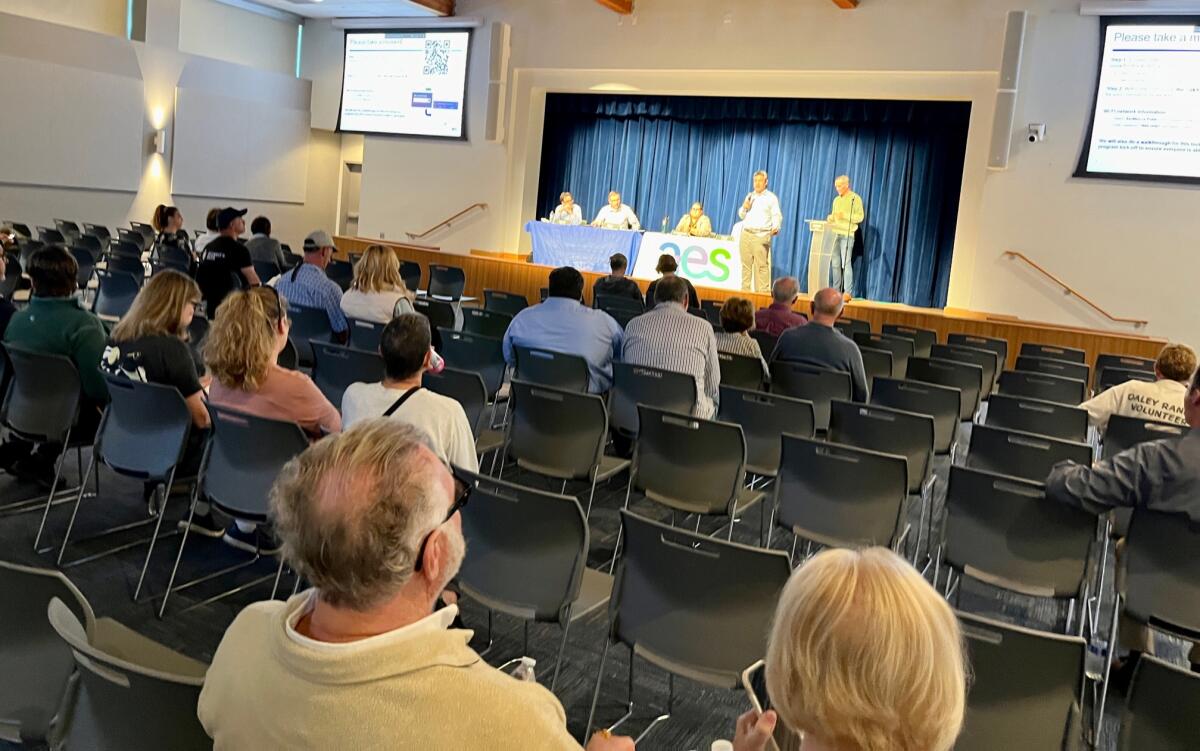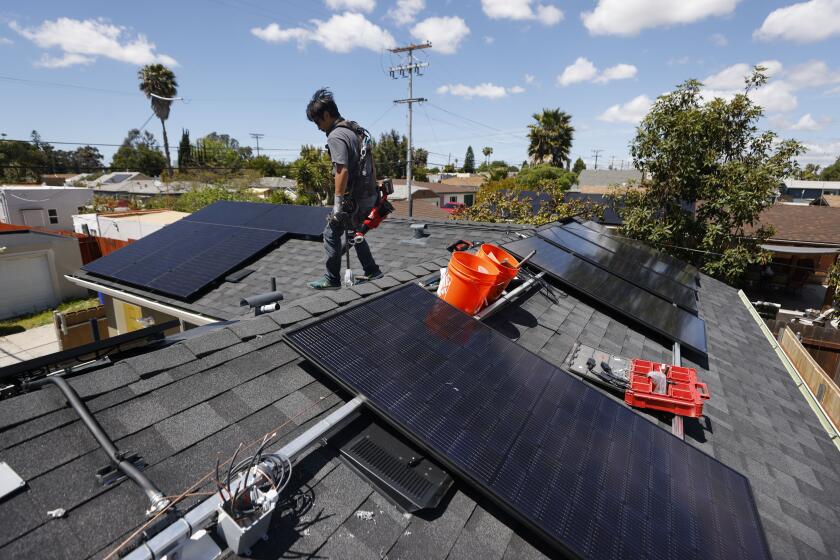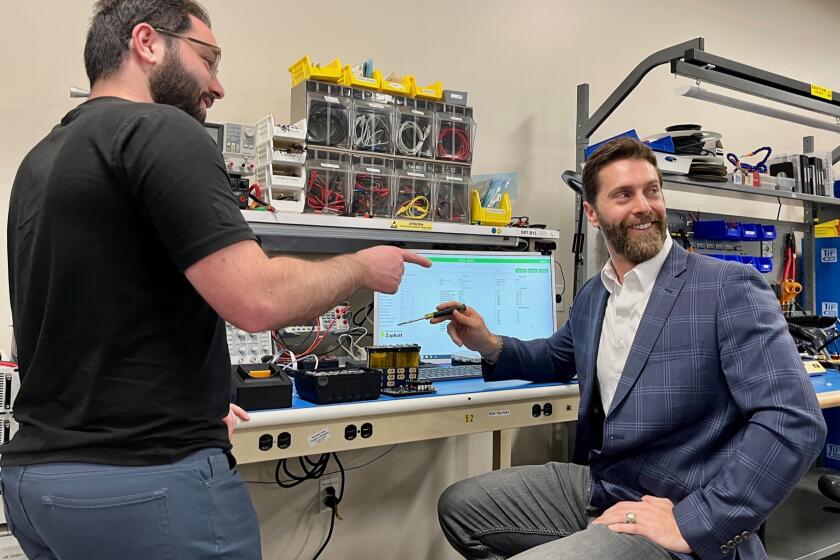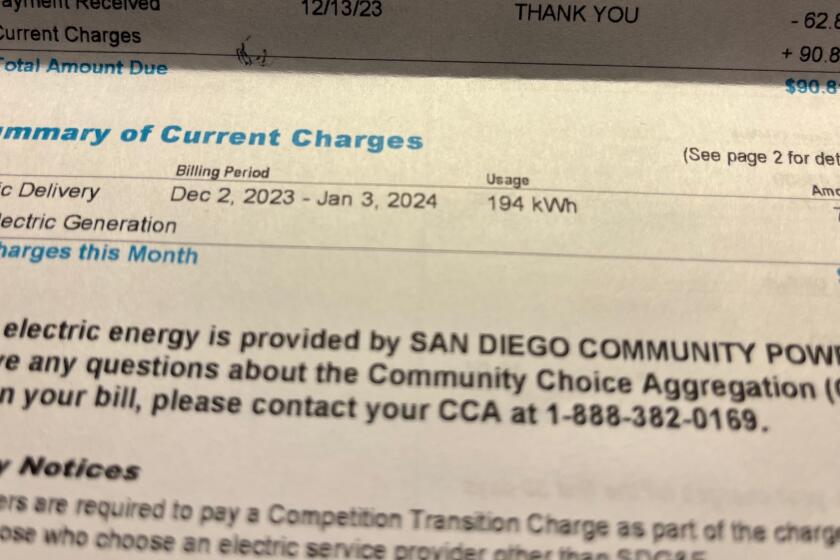Why this battery storage plant between Escondido and San Marcos has some residents upset

The Seguro Energy Storage project could power 240,000 homes for up to four hours, but it’s proving to be a hard sell for those who live nearby
A renewable energy company that wants to construct a battery storage project between San Marcos and Escondido has scaled back the footprint of the proposed facility — but judging from reaction at a recent public meeting, many homeowners in the area still don’t want it built.
Officials at AES, a global Fortune 500 energy company, say the 22.5-acre site for the Seguro Energy Storage Project is located in a prime parcel of private land. It’s close to an existing San Diego Gas & Electric substation so the project in Eden Valley can feed into the state’s power system without requiring miles of overhead transmission lines.
The company hosted a workshop on March 21 at the city hall complex in San Marcos and announced the battery storage system would generate 320 megawatts and 1,280 megawatt-hours of electricity that would flow to California’s grid. That’s 20 percent smaller than the original proposal that called for 400 megawatts and 1,600 megawatt-hours of storage capacity.
“We’ve reduced that project size to take into account some of the information received as part of our studies, as part of the environmental review process, as well as some community feedback,” said Max Guaniere, development manager for AES.
But the two-hour session didn’t change the mind of Janet Nicolls, who for 25 years has lived in a home in Escondido, not far from the project’s potential location southwest of the junction of state Route 78 and Interstate 15, off Country Club Drive.
“It’s the wrong project in the wrong place,” she said.
Concerns from locals
The biggest complaint many residents bring up is safety — in particular, the possibility of a fire breaking out at the facility.
Though relatively rare, there have nonetheless been multiple instances of excessive heat inside a battery leading to a chemical reaction that spreads in a chain reaction to other batteries in what’s called “thermal runaway.”
It’s happened in hand-held devices, electric vehicles, e-bikes and in battery storage facilities.
An explosion in 2019 at an energy storage facility in Surprise, Ariz., injured nine first responders. Fires broke out at three separate battery projects in New York state last summer, although no injuries were reported.
In California, a Tesla Megapack caught fire in September 2022 at a battery storage facility operated by Pacific Gas & Electric in the Northern California town of Moss Landing. No injuries were reported, but California Highway Patrol closed a section of Highway 1 and redirected traffic away from the site for hours.
Closer to home, a fire broke out last September at the Valley Center Energy Storage Facility, operated by renewable energy company Terra-Gen.
While fire officials said the fire was put out in about 45 minutes and extinguished by the site’s internal fire prevention system, businesses and the small number of homes within a quarter-mile of the industrial park where the facility is located were evacuated and shelter-in-place orders were in effect within a half-mile of the site out of an abundance of caution.
The 139-megawatt, 560 megawatt-hour Valley Center facility was back in operations the next day.

Adding to the anxiety of some residents near the proposed Seguro site is whether there are enough accessible roads to allow them to quickly clear out in case of an emergency.
“We’ve been evacuated because of wildfires (in the area) twice,” Nicolls said. “There are people in the valley who own horses, donkeys, all kinds of animals, and for them to evacuate was very difficult.”
Assurances from AES
Between eight to 10 AES employees will oversee and maintain the Seguro facility. The team will be on call in case any issues pop up after normal business hours. The site will also be monitored 24/7 from the company’s remote operations control center.
To help prevent battery modules from starting a fire, AES says the project’s design will comply with standards set by the National Fire Protection Association, as well as “the latest and most rigorous” standards for battery energy storage systems.
The company pledges to create an emergency response plan, which includes training local fire and EMS personnel on the project’s equipment and emergency response protocols.
If a battery fire occurred, AES says the enclosures on the site are designed to release fire suppressants “in large concentrations directly into the initiating cell,” which would remove heat and prevent thermal runaway. The battery modules will be inside steel containers equipped with fire insulation and several redundant layers of hazard controls.
The company says Seguro will be designed to make sure that if something goes wrong with a battery, the failure would be contained within the module and will not cause ignition, explosion or spread fire to nearby equipment.
As for concerns about congestion on evacuation routes, AES says the roadway on nearby Milpas Drive will be improved to allow first responders and residents to travel along the street more efficiently. Plus, an alternative access route will be added to the north of the facility so that drivers will have more than one road in and out.
The company has increased setbacks to the project to no less than 130 feet from the nearest residence, expanded the spacing between containers to further reduce the risk of fires spreading and promised to add more fire hydrants in the area.
“We are going to design this project to be the safest in the world when it’s built,” said Guaniere of AES.
David Ecklund, whose family lives on a 2-acre parcel directly behind where the project would go, called the project “ridiculous.”
“You can take all the safety issues and tell me, ‘Yeah, this will work.’ But you know what? Things happen,” he said. “I’m not against the batteries; I’m against where they’re wanting to put it.”
Other issues
There are other energy facilities concentrated in the immediate vicinity of the Seguro project.
In addition to SDG&E’s Escondido substation, the utility operates the 565-megawatt combined-cycle natural gas Palomar Energy Center, the 50-megawatt gas-fired Escondido Energy Center, plus its own 30-megawatt battery storage facility.
Directly east, CalPeak Power operates the 49.5-megawatt Enterprise Emergency Peaker Project that generates natural gas when the state’s electric grid needs it.
In addition, the nearby Palomar Medical Center has a central plant that includes diesel engine generators and north of Seguro sits a sheet metal fabrication plant.
“We’re not NIMBYs (‘not in my backyard’) because we’ve had all this stuff happen around us,” said Julie Taylo, who shares a house with Nicolls in Escondido. “It’s just at some point, it gets to be too much.”
AES already operates six battery storage facilities in California and during the March 21 workshop company representatives pointed to a chart from the Electric Power Research Institute showing that the number of “failure events” has gone down since 2021 while the number of global storage facilities in operation have increased 20-fold in the past five years.
“The technology is improving,” said Corinne Bonine, AES permitting director for the Seguro project. “The occurrence of these incidents is rapidly declining.”
A battery boom in California
Energy storage has taken on a higher profile in recent years as more renewable sources of power have come onto California’s electric grid.
Solar production is abundant during the day but practically vanishes after sunset or when smoke and clouds obscure the skies. And when the wind doesn’t blow, production from wind farms peters out. Energy storage — particularly from batteries — is seen as a key way to fill the gaps.
Storage systems take solar power generated during the day and discharge the electricity later, especially from 4 to 9 p.m. when California’s grid is under the most stress.
Batteries can help reduce the risk of rotating power outages and replace natural gas “peaker plants” used during those critical hours when customers crank up their air conditioners.
Boosting energy storage is crucial for California to reach its target of deriving 100 percent of electricity from carbon-free sources by 2045.
Five years ago, the state counted a mere 250 megawatts of battery storage available to the California Independent System Operator, which manages the grid for 80 percent of the state and a small part of Nevada.
In July 2023, California counted 6,617 megawatts of energy storage and by 2045 the state’s goal is have 52,000 megawatts online.
At the same time, the size of the facilities keeps growing.
Calpine Corporation is nearing the completion of the largest battery storage facility in California. The Nova Power Bank in Menifee expects to have generation capacity of 680 megawatts by the time construction of the entire project wraps up next year. That’s enough capability to power 680,000 homes for up to four hours.
By comparison, the Seguro project is expected to provide enough stored energy to power about 240,000 homes for four hours.
The elements that will make up the batteries at Seguro are still to be determined, although Guaniere said they will use lithium-ion technology. When asked how much the project will cost, he wouldn’t give a dollar amount, saying making an estimate would be premature.
“These types of projects can be expensive, based on their size,” Guaniere said. “As many people know, renewable projects are very capital intensive.”
Whatever the price tag, Stephanie Heaton of Escondido is against the project. “It’s an accident waiting to happen,” she said.
The Seguro proposal will be reviewed by government and regulatory agencies under the California Environmental Quality Act, known as CEQA. San Diego County is in the process of conducting an environmental impact report before going to the county’s Planning Commission.
If approved, AES plans to have the project up and running by late 2026.
Get U-T Business in your inbox on Mondays
Get ready for your week with the week’s top business stories from San Diego and California, in your inbox Monday mornings.
You may occasionally receive promotional content from the San Diego Union-Tribune.












